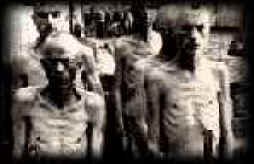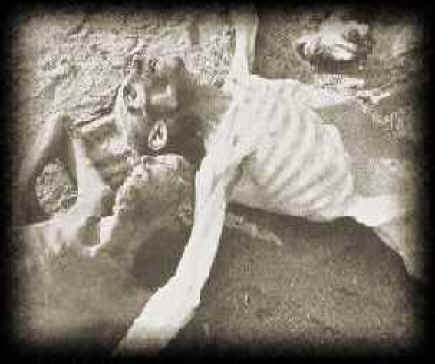


|
|
|
| The Holocaust is probably one of the worst tragedies of the history. You can't even explain how terrible it was. Millions and millions of Jews were put through this terrifying time of history. They were killed and murdered in different death camps. Three of the many death camps are Belzec, Sobibor, and Treblinka. |
|
| Belzec, Sobibor, and Treblinka are all a huge part of the Nazi killing machine in Poland. These camps served one purpose and one purpose only: the total destruction of the Jewish people. | |
| Operation Reinhard is the largest single massacre action of the holocaust. Operation Reinhard lasted twenty-one months, from March 1942 to November 1943. The commander of Operation Reinhard was Globocnik, Christian Wirth, and the SS men helped them out. Belzec, Sobibor, and Treblinka were relatively small and compact. The killing system was developed by Christian Wirth. It enabled tens of thousands of Jews murdered everyday in three death camp under his jurisdiction. Almost all of the victims were sent to the gas chambers believing that they were baths. The Jews that were selected for work at the camps and who were aware of what was going on didn't give up. A few prisoners in Sobibor and Treblinka succeeded in caring out individual escapes and in staging an uprise and including an escape. The uprising ensured the secrets of the death camps to the world. The perpetrators did not succeed in their attempts to bury and burn the truth of the camps and the victims. | |
| Sobibor was a camp in Operation Reinhard but the head commander was Hauptsturmfuhrer Franz Reichleitener. Operations lasted from May 1942 until October 1943. Sobibor was the smallest camp of Operation Reinhard. It's five gas champers killed an approximate number of 250,000 Jews. About fifty prisoners survived to tell their story to the world. | |
| Treblinka was one of the most important death camps during World War 2. Operations of Treblinka were ready to start in July, 1942. Treblinka was under the command of Franz Stangl. The killing process of Treblinka was very similar to the killings of Belzec and Sobibor. Between July 1942 to September 1942, 300,000 Jews were transported from Warsaw to Treblinka. Later in May of 1943, the entire population of the Warsaw ghetto was liquidated and most of them were transported to Treblinka. By July 11,1945, when the Soviet troops entered Warsaw, more than 700,000 Jews were murdered at Treblinka. In 1967, Franz Stangl was arrested in Brazil . In December, 1970, he was sentenced to life in prison for his part in the murder of 400,000 people. He died in the prison the following June. |
|
| Belzec was situated in the Lublin district forty-seven miles north of the major city of Lvov, conveniently between the large Jewish populations of south east Poland and eastern Galicia. The commander was Christian Wirth. They used the fixed gas chamber with gas produced by the internal-combustion engine of a motorcar. A report by a German officer describes how Jews rounded up in their villages were packed 200 to each cattle car. The journey to the Belzec death camp sometimes took more than a day without food or water. Jews constantly tried to break out walls and ceilings of the cars. Many succeeded but were shot by the soldiers guarding the cars. Jews were told before being assigned to labor duties they would be showered and disinfected. Men were separated from women and children and were marched off to large huts and were forced to undress. Women's hair was shaven off. They were then brutally pushed into the "tube" and into the gas chambers disguised as "showers." The process of killing took about 30 minutes. Men, women, and children filing past in ghastly parade as a burly SS man promised in a loud voice that nothing terrible was going to happen to them. "All you have to do is breathe in deeply. That strengthens the lungs. Inhaling is a means of preventing infection diseases. It's a good method of disinfections." To those who as their fate, the SS men gave them more reassurance. Edward Luczynski from a 1964 trial of German officers. "After the doors were opened, it was often that some people were still alive. Children were on the floor and adults with their faces against the cracks sometimes managed to survive. The survivors were killed." Jewish workers removed gold teeth from bodies. Only a handful of survivors from Belzec. Probably a dozen thousand of Gypsies were murdered. Around 1943 the camp was closed. Locals looked for valuables but were driven off by guards. To keep them away, a German SS man made a farm out of it. | |
| In 1942, thirty-seven year old, Kurt Gerstein was appointed head of the Technical Disinfections Department of the Waffen SS, responsible for improving the highly toxic prussic acid Zyklon B. He was sent to introduce it to the other camps. | |
| Kurt was deeply shaken by what he saw and witnessed. He wanted to inform the Allies about what the Nazi's were doing and eventually risked his life to do this. He describes how the Jews were forced to undress. There were piles of shoes that were allegedly 25 meters high. Kurt desperately tried to alert the world about the atrocities. | |
| " I see everything! The mothers, their babies at the breast, the little naked children, the men and women, naked. They entered into the death chamber, pushed by the leather whips of the SS men. Packed well, that is what the captain ordered. There were 7 to8 hundred persons on 25 square meters. More than half are children..." | |
| " One could tell families even in death. They were still holding hands, stiffened in death so that it was difficult to tear them apart to clear the chambers for the next load," Gerstien wrote. | |
| " There are not 10 people alive who have seen or will see as much as you," he was told by SS major Christian Wirth, responsible for overseeing the murder of more than two million Jews in the death camps Belzec, Sobibor, and Treblinka. | |
| Kurt showed true heroism, he tirelessly denounced Hitler's Nazi genocide and alerted the Allies. All of his efforts proved futile and Kurt died in a French prison on July 25, 1945. He was overwhelmed by a sense of personal responsibility and gilt. | |
|
Shelby Cowan 7th Social Studies Rossville Jr. High Holocaust Project 2004 |